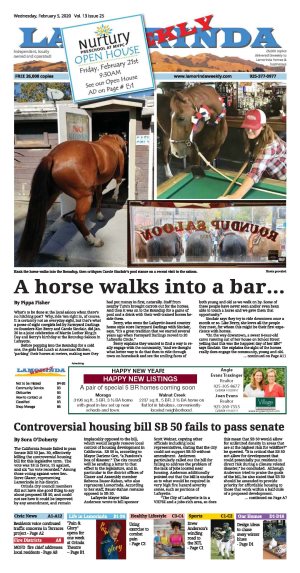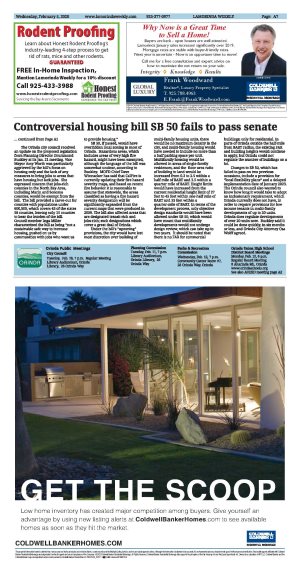| | Published February 5th, 2020
| Controversial housing bill SB 50 fails to pass senate
| | | By Sora O'Doherty | | |
The California Senate failed to pass Senate Bill 50 Jan. 30, effectively killing the controversial housing bill for this legislative term. The vote was 18 in favor, 15 against, and six "no vote recorded." Among those voting against were Sen. Steve Glazer, representing Lamorinda in his district.
 Orinda city council members did not have one good thing to say about proposed SB 50, and could not see how it could be improved by any amendment, and remain implacably opposed to the bill, which would largely remove local control of housing development in California. SB 50 is, according to Mayor Darlene Gee, "a Pandora's box of disaster." The city council will be sending a letter to that effect to the legislature, and in particular to the district offices of Glazer and Assembly member Rebecca Bauer-Kahan, who also represents Lamorinda. According to her staff, Bauer-Kahan remains opposed to SB 50.
Orinda city council members did not have one good thing to say about proposed SB 50, and could not see how it could be improved by any amendment, and remain implacably opposed to the bill, which would largely remove local control of housing development in California. SB 50 is, according to Mayor Darlene Gee, "a Pandora's box of disaster." The city council will be sending a letter to that effect to the legislature, and in particular to the district offices of Glazer and Assembly member Rebecca Bauer-Kahan, who also represents Lamorinda. According to her staff, Bauer-Kahan remains opposed to SB 50.
 Lafayette Mayor Mike Anderson wrote to bill sponsor Scott Weiner, copying other officials including local representatives, stating that the city could not support SB 50 without amendment. Anderson particularly called out the bill for failing to address the problem of the lack of jobs located near housing. Anderson additionally pointed out that the bill is unclear as to what would be required in very high fire hazard severity zones, such as portions of Lafayette.
Lafayette Mayor Mike Anderson wrote to bill sponsor Scott Weiner, copying other officials including local representatives, stating that the city could not support SB 50 without amendment. Anderson particularly called out the bill for failing to address the problem of the lack of jobs located near housing. Anderson additionally pointed out that the bill is unclear as to what would be required in very high fire hazard severity zones, such as portions of Lafayette.
 "The City of Lafayette is in a VHFSZ and a jobs-rich area, so does this mean that SB 50 would allow for unlimited density in areas that are at the highest risk for wildfire?" he queried. "It is critical that SB 50 not allow for development that could potentially put residents in direct risk during a climate related disaster," he concluded. Although Anderson tried to praise the goals of the bill, he also stated that SB 50 should be amended to provide priority for affordable housing to those that work within a half-mile of a proposed development.
"The City of Lafayette is in a VHFSZ and a jobs-rich area, so does this mean that SB 50 would allow for unlimited density in areas that are at the highest risk for wildfire?" he queried. "It is critical that SB 50 not allow for development that could potentially put residents in direct risk during a climate related disaster," he concluded. Although Anderson tried to praise the goals of the bill, he also stated that SB 50 should be amended to provide priority for affordable housing to those that work within a half-mile of a proposed development.
 The Orinda city council received an update on the proposed legislation from Planning Director Drummond Buckley at its Jan. 21 meeting. Vice Mayor Amy Worth was particularly aggrieved by the bill's focus on housing only and the lack of any measures to bring jobs to areas that have housing but lack jobs. She expressed concern that jobs-rich counties in the North Bay Area, including Marin and Sonoma counties, would be exempt from the bill. The bill provided a carve-out for counties with populations under 600,000, which covers 43 of the states 58 counties, leaving only 15 counties to bear the burden of the bill. Council member Inga Miller characterized the bill as being "not a sustainable safe way to increase housing, pushed on us by communities with jobs who want us to provide housing."
The Orinda city council received an update on the proposed legislation from Planning Director Drummond Buckley at its Jan. 21 meeting. Vice Mayor Amy Worth was particularly aggrieved by the bill's focus on housing only and the lack of any measures to bring jobs to areas that have housing but lack jobs. She expressed concern that jobs-rich counties in the North Bay Area, including Marin and Sonoma counties, would be exempt from the bill. The bill provided a carve-out for counties with populations under 600,000, which covers 43 of the states 58 counties, leaving only 15 counties to bear the burden of the bill. Council member Inga Miller characterized the bill as being "not a sustainable safe way to increase housing, pushed on us by communities with jobs who want us to provide housing."
 SB 50, if passed, would have overridden local zoning in most of Orinda. Hazardous areas, which includes areas of very high fire hazard, might have been exempted, although the language of the bill was somewhat unclear, according to Buckley. MOFD Chief Dave Winnacker has said that CalFire is currently updating their fire hazard severity maps, and based on recent fire behavior it is reasonable to assume that statewide, the areas classified as having a fire hazard severity designation will be significantly expanded from the current maps that were produced in 2009. The bill also affected areas that are designated transit-rich and jobs-rich; such designations which cover a great deal of Orinda.
SB 50, if passed, would have overridden local zoning in most of Orinda. Hazardous areas, which includes areas of very high fire hazard, might have been exempted, although the language of the bill was somewhat unclear, according to Buckley. MOFD Chief Dave Winnacker has said that CalFire is currently updating their fire hazard severity maps, and based on recent fire behavior it is reasonable to assume that statewide, the areas classified as having a fire hazard severity designation will be significantly expanded from the current maps that were produced in 2009. The bill also affected areas that are designated transit-rich and jobs-rich; such designations which cover a great deal of Orinda.
 Under the bill's "upzoning" provisions, the city would have lost most discretion over building of multi-family housing units, there would be no maximum density in the city, and multi-family housing would have needed to include no more than a half parking space per unit. Multifamily housing would be allowed in areas of single-family residences, and the floor area ratio of building to land would be increased from 0.2 to 2.5 within a half mile of BART and 3.5 within a quarter mile of BART. Height limits would have increased from the current residential height limit of 27 feet to 45 feet within one-half mile of BART and 55 feet within a quarter-mile of BART. In terms of the development process, only objective design standards would have been allowed under SB 50, which would have meant that multifamily developments would not undergo design review, which can take up to two years. It should be noted that there is no FAR for commercial buildings; only for residential. In parts of Orinda outside the half-mile from BART radius, the existing FAR and building heights would continue to apply, but Orinda could not regulate the number of buildings on a lot.
Under the bill's "upzoning" provisions, the city would have lost most discretion over building of multi-family housing units, there would be no maximum density in the city, and multi-family housing would have needed to include no more than a half parking space per unit. Multifamily housing would be allowed in areas of single-family residences, and the floor area ratio of building to land would be increased from 0.2 to 2.5 within a half mile of BART and 3.5 within a quarter mile of BART. Height limits would have increased from the current residential height limit of 27 feet to 45 feet within one-half mile of BART and 55 feet within a quarter-mile of BART. In terms of the development process, only objective design standards would have been allowed under SB 50, which would have meant that multifamily developments would not undergo design review, which can take up to two years. It should be noted that there is no FAR for commercial buildings; only for residential. In parts of Orinda outside the half-mile from BART radius, the existing FAR and building heights would continue to apply, but Orinda could not regulate the number of buildings on a lot.
 Changes to SB 50, which has failed to pass on two previous occasions, include a provision for "local flexibility plans" and a delayed implementation date of January 2023. The Orinda council also wanted to know how long it would take to adopt an inclusionary requirement, which Orinda currently does not have, in order to require provisions for low income tenants in multi-family developments of up to 20 units. Orinda does regulate developments of over 20 units now. Buckley said it could be done quickly, in six months or less, and Orinda City Attorney Osa Wolff agreed.
Changes to SB 50, which has failed to pass on two previous occasions, include a provision for "local flexibility plans" and a delayed implementation date of January 2023. The Orinda council also wanted to know how long it would take to adopt an inclusionary requirement, which Orinda currently does not have, in order to require provisions for low income tenants in multi-family developments of up to 20 units. Orinda does regulate developments of over 20 units now. Buckley said it could be done quickly, in six months or less, and Orinda City Attorney Osa Wolff agreed. |
| | | | | | | | | | | | |



